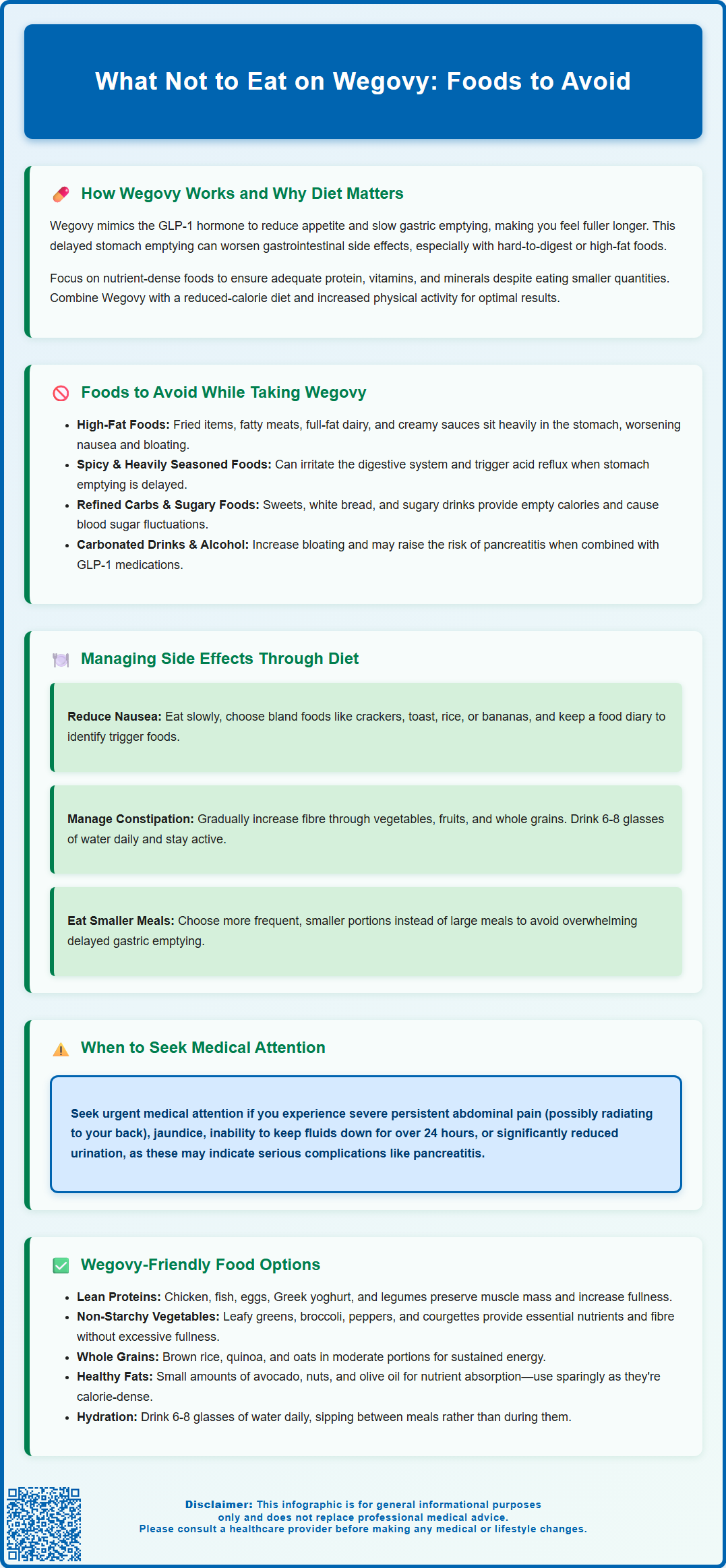Mounjaro®
Dual-agonist support that helps curb appetite, hunger, and cravings to drive substantial, sustained weight loss.
- ~22.5% average body weight loss
- Significant weight reduction
- Improves blood sugar levels
- Clinically proven weight loss

Wegovy (semaglutide 2.4 mg) is a GLP-1 receptor agonist licensed by the MHRA for chronic weight management in adults with obesity or overweight with weight-related comorbidities. Whilst the medication effectively reduces appetite and slows gastric emptying, certain foods can significantly worsen common gastrointestinal side effects such as nausea, vomiting, and abdominal discomfort. Understanding what not to eat on Wegovy is essential for optimising treatment outcomes, minimising adverse reactions, and ensuring adequate nutrition despite reduced food intake. Strategic dietary modifications complement the medication's mechanism of action, supporting sustainable weight loss whilst maintaining overall health throughout your treatment course.
Summary: Avoid high-fat foods, fried items, spicy dishes, refined carbohydrates, sugary foods, carbonated beverages, alcohol, and large portions whilst taking Wegovy to minimise gastrointestinal side effects.
Wegovy (semaglutide 2.4 mg) is a glucagon-like peptide-1 (GLP-1) receptor agonist licensed by the MHRA for chronic weight management in adults with obesity (BMI ≥30 kg/m²) or overweight (BMI ≥27 kg/m²) with at least one weight-related comorbidity. It is prescribed as an adjunct to a reduced-calorie diet and increased physical activity. The medication works by mimicking the naturally occurring hormone GLP-1, which regulates appetite and food intake through several mechanisms.
Semaglutide slows gastric emptying, meaning food remains in the stomach for longer periods. This effect is typically most pronounced during dose titration and may diminish over time. This delayed emptying creates a sensation of fullness that persists after meals. Additionally, Wegovy acts on appetite centres in the brain, reducing hunger signals and helping patients feel satisfied with smaller portions. The medication also influences insulin secretion and glucagon release, contributing to improved glycaemic control in those with type 2 diabetes.
Why dietary choices matter significantly when taking Wegovy relates directly to these mechanisms of action. Because the drug delays stomach emptying, certain foods can exacerbate common gastrointestinal side effects such as nausea, vomiting, abdominal discomfort, and constipation. Foods that are difficult to digest, high in fat, or particularly rich may sit heavily in the stomach, intensifying feelings of fullness to an uncomfortable degree.
Moreover, whilst Wegovy supports weight loss by reducing appetite, nutritional quality remains paramount. Patients eating very small quantities must ensure adequate intake of essential nutrients, protein, vitamins, and minerals. NICE guidance emphasises that pharmacological interventions for weight management should be accompanied by appropriate dietary modification and increased physical activity. Understanding which foods to limit or avoid can help optimise treatment outcomes, minimise adverse effects, and support sustainable, healthy weight loss throughout your treatment course.
Note: If you take other medicines, inform your healthcare professionals about Wegovy treatment, as delayed gastric emptying may affect absorption of some oral medications (for example, if you take warfarin, more frequent INR monitoring may be needed).
Certain food categories are particularly likely to trigger or worsen gastrointestinal side effects when taking Wegovy. High-fat foods top the list of items to limit or avoid. Fried foods, fatty cuts of meat, full-fat dairy products, pastries, and creamy sauces can sit heavily in the stomach, which is already emptying more slowly due to semaglutide's action. This combination frequently leads to prolonged nausea, bloating, and discomfort. High-fat meals may also aggravate symptoms if you develop gallbladder problems, which can occur with weight loss and GLP-1 therapies.
Spicy and heavily seasoned foods may irritate the digestive system for some individuals, particularly when gastric emptying is delayed. Dishes containing chilli peppers, hot sauces, or strong spices can exacerbate nausea and may trigger acid reflux or heartburn, which some patients report more frequently whilst on GLP-1 receptor agonists. Responses to spicy foods vary between individuals, so monitor your personal tolerance.
Refined carbohydrates and sugary foods—including sweets, biscuits, cakes, white bread, and sugar-sweetened beverages—should be minimised. These provide empty calories with minimal nutritional value, which is problematic when overall food intake is reduced. Additionally, high-sugar foods can cause rapid blood glucose fluctuations, potentially leading to energy crashes and increased cravings.
Carbonated and alcoholic beverages warrant caution. Fizzy drinks can increase bloating and gastric discomfort, whilst alcohol may intensify nausea and carries its own caloric burden. There is no official contraindication between Wegovy and alcohol, but UK Chief Medical Officers advise limiting alcohol to no more than 14 units per week, spread over three or more days, and avoiding binge drinking. Heavy alcohol consumption may increase the risk of pancreatitis, a rare but serious side effect of GLP-1 medications.
Large portion sizes and heavy meals—regardless of content—should be avoided. Even nutritious foods consumed in excessive quantities can overwhelm the delayed gastric emptying, causing significant discomfort. Eating smaller, more frequent meals throughout the day typically proves more tolerable and helps maintain steady energy levels whilst supporting your weight management goals.

Gastrointestinal side effects are the most commonly reported adverse reactions to Wegovy, particularly during the initial titration phase. According to the MHRA product information, nausea affects approximately 44% of patients, whilst vomiting, diarrhoea, constipation, and abdominal pain are also frequently observed. Strategic dietary modifications can significantly reduce the severity and duration of these symptoms.
To minimise nausea, eat slowly and chew food thoroughly, allowing your body time to register fullness signals. Stop eating as soon as you feel comfortably satisfied rather than continuing to a feeling of fullness. Bland, easily digestible foods—such as plain crackers, toast, rice, or bananas—are often better tolerated, especially if you're experiencing active nausea. Some people find ginger tea helpful, though evidence is limited.
Avoiding trigger foods identified through personal experience is essential. Keep a food diary to track which items worsen your symptoms, as individual responses vary. Common culprits include greasy takeaways, rich desserts, and very large meals, but you may discover personal triggers unique to your digestive system.
For constipation management, ensure adequate fibre intake through vegetables, fruits, whole grains, and legumes, introduced gradually to avoid bloating. Hydration is critical—aim for 6-8 glasses (about 1.2-1.5 litres) of water daily unless otherwise advised by your healthcare provider. Regular physical activity also supports healthy bowel function.
IMPORTANT: Seek urgent medical attention and stop taking Wegovy if you experience severe, persistent abdominal pain (which may radiate to your back), with or without vomiting, as this could indicate pancreatitis. Also seek prompt medical advice if you develop right upper abdominal pain, yellowing of the skin/eyes (jaundice), cannot keep fluids down for more than 24 hours, or notice markedly reduced urine output.
If you have type 2 diabetes and use insulin or sulfonylureas, monitor for signs of low blood sugar and discuss possible dose adjustments with your healthcare team.
For persistent but less severe side effects, your clinician may recommend slowing the dose titration or temporarily reducing to a previously tolerated dose. Report suspected side effects via the MHRA Yellow Card Scheme (yellowcard.mhra.gov.uk or the Yellow Card app).
Adopting a nutrient-dense, balanced diet whilst taking Wegovy ensures you meet nutritional requirements despite reduced food intake. Focus on foods that provide maximum nutritional value in smaller portions, supporting both weight loss and overall health.
Lean protein sources should feature prominently in your diet. Options include:
Skinless chicken or turkey breast
White fish (cod, haddock, plaice)
Eggs (boiled, poached, or scrambled with minimal fat)
Low-fat Greek yoghurt
Tofu and other soya-based products
Legumes such as lentils and chickpeas
Protein helps preserve muscle mass during weight loss, promotes satiety, and supports tissue repair. Aim to include a protein source with each meal.
Non-starchy vegetables provide essential vitamins, minerals, and fibre with minimal calories. Leafy greens, broccoli, cauliflower, peppers, courgettes, tomatoes, and mushrooms can be consumed generously. These foods support digestive health and provide bulk without overwhelming your reduced stomach capacity.
Whole grains in moderate portions—such as brown rice, quinoa, wholemeal bread, and oats—offer sustained energy release and additional fibre. Choose these over refined alternatives, but be mindful of portion sizes to avoid excessive fullness.
Healthy fats in small amounts remain important for nutrient absorption and hormonal health. Include modest quantities of avocado, nuts, seeds, and olive oil, recognising that whilst these are nutritious, they're calorie-dense and may trigger discomfort in larger amounts.
Hydration cannot be overstated. Water should be your primary beverage, with NHS guidance recommending 6-8 glasses (about 1.2-1.5 litres) daily. Consider sipping fluids between rather than during meals to avoid premature fullness. Herbal teas and diluted sugar-free squash provide variety.
Meal timing and structure can be adjusted based on your tolerance. Many people find smaller, more frequent meals helpful while taking Wegovy, but this isn't essential—focus on portion control and responding to your body's satiety cues. Planning meals in advance helps ensure nutritional adequacy and prevents reliance on convenience foods that may not support your treatment goals.
If you're struggling to maintain adequate nutrition due to reduced intake, consider discussing a referral to a dietitian with your healthcare provider.
High-fat foods such as fried items, fatty meats, and creamy sauces sit heavily in the stomach, which empties more slowly due to Wegovy's mechanism of action. This combination frequently leads to prolonged nausea, bloating, and significant abdominal discomfort.
There is no official contraindication between Wegovy and alcohol, but alcohol may intensify nausea and carries its own caloric burden. UK Chief Medical Officers advise limiting alcohol to no more than 14 units per week, and heavy consumption may increase the risk of pancreatitis.
Seek urgent medical attention and stop taking Wegovy if you experience severe, persistent abdominal pain (which may radiate to your back), with or without vomiting, as this could indicate pancreatitis. Also seek prompt medical advice if you develop jaundice or cannot keep fluids down for more than 24 hours.
The health-related content published on this site is based on credible scientific sources and is periodically reviewed to ensure accuracy and relevance. Although we aim to reflect the most current medical knowledge, the material is meant for general education and awareness only.
The information on this site is not a substitute for professional medical advice. For any health concerns, please speak with a qualified medical professional. By using this information, you acknowledge responsibility for any decisions made and understand we are not liable for any consequences that may result.
Lorem ipsum dolor sit amet, consectetur adipiscing elit, sed do eiusmod tempor incididunt ut labore et dolore magna aliqua. Ut enim ad minim veniam, quis nostrud exercitation ullamco laboris nisi ut aliquip ex ea commodo consequat. Duis aute irure dolor in reprehenderit in voluptate velit esse cillum dolore eu fugiat nulla pariatur.
Block quote
Ordered list
Unordered list
Bold text
Emphasis
Superscript
Subscript